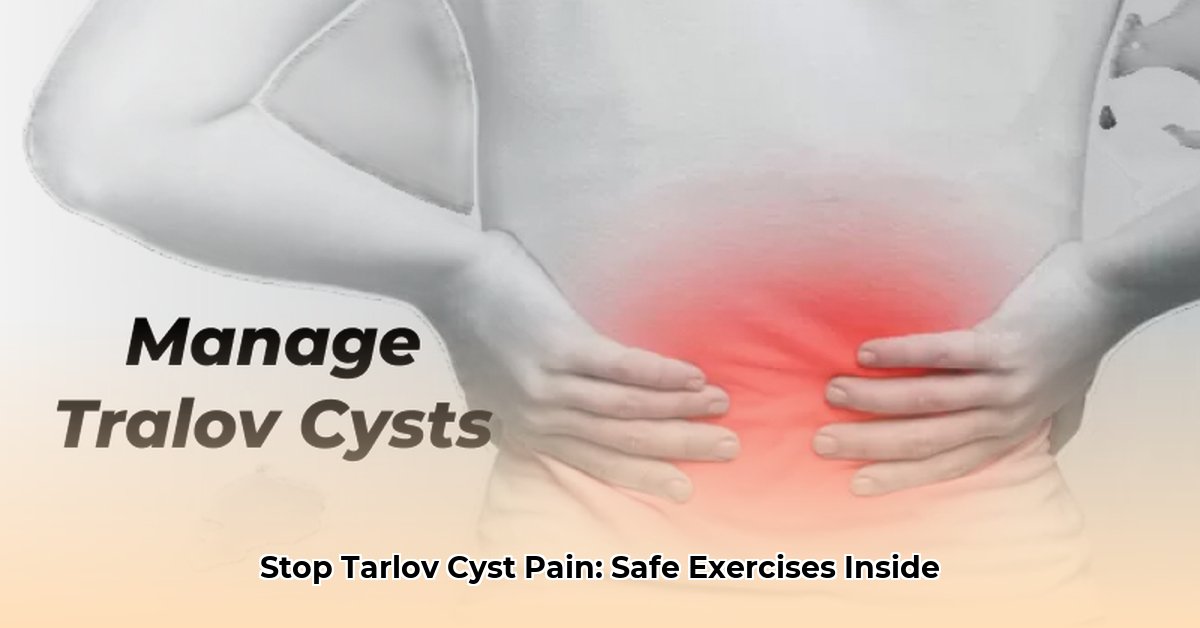Dealing with a Tarlov cyst? Figuring out what exercises are safe can be tricky. This guide is here to help you understand which moves to avoid to keep your pain under control and prevent any problems down the road. We’ll show you exactly which exercises you should skip and offer advice on how to stay active safely. For additional pain management tips, check out this resource on [pain relief options](https://chaztin.com/ethyl-chloride-spray/). Whether you’re a seasoned athlete or just starting your fitness journey, we’ll provide clear, easy-to-understand information so you can confidently manage your condition and maintain an active lifestyle.
Exercises to Avoid and Safe Movement with Tarlov Cysts
Living with Tarlov cysts doesn’t mean you have to say goodbye to exercise and an active lifestyle. However, knowing which exercises to avoid is key to managing your pain and protecting your spine. Let’s explore how to move safely and comfortably, considering your spinal health and well-being.
High-Impact Activities Impact on Spinal Health
High-impact exercises – like running sprints, bouncing jacks, and intense plyometrics – put considerable pressure on your lower back, a risk factor that can inflame your spine. This extra stress can irritate your Tarlov cysts, potentially leading to more pain and discomfort. Gentle, low-impact movement is a better approach when figuring out exercises to avoid and movement with Tarlov Cysts to maintain an active lifestyle.
Consider this: The jarring impact from high-impact activities could potentially cause or worsen existing cyst issues. While research on Tarlov cysts and exercise is ongoing, many healthcare professionals suggest avoiding these activities as a precautionary measure, and to support your spine health. The goal is to minimize any risk of further spinal problems, inflammation, or the aggravation of existing Tarlov cysts.
Bending and Twisting motions on Tarlov Cysts
Activities involving a lot of bending forward (spinal flexion) or twisting can also flare up Tarlov cyst symptoms. Deep forward bends, traditional sit-ups (those where you crunch your whole body), and twisting motions like those in golf or tennis should be approached with extreme caution, if at all.
Why the caution? Excessive bending or twisting might increase pressure on the cysts and nearby nerves, potentially causing pain. Some experts suggest that these movements could strain the already delicate tissues surrounding the cysts, leading to inflammation. It’s best not to risk exacerbating the problem, especially when considering the potential for nerve irritation. Instead of these potentially problematic movements, explore gentler alternatives. We’ll cover some safe options later in the article.
Heavy Lifting and Abdominal Pressure
Lifting heavy objects significantly increases abdominal pressure, which could potentially impact your Tarlov cysts. This pressure can make your pain much worse. Instead of hoisting heavy weights, focus on bodyweight exercises or lighter weights with higher repetitions. Pay close attention to what your body is telling you.
The increased abdominal pressure from heavy lifting may put undue stress on the spinal column, affecting the Tarlov cysts. Although more research is needed to establish the link definitively, many clinicians recommend minimizing heavy lifting to minimize potential irritation. Remember, your health is your priority.
Extended Static Postures: Impacts on Spinal Discomfort
Spending too long in the same position—slouching on the sofa for hours, sitting at a desk without moving—can also contribute to Tarlov cyst pain and discomfort, highlighting the impact on spinal health. Constantly shifting your body and changing positions helps relieve pressure on your back.
Prolonged static postures may lead to muscle imbalances and stiffness, potentially increasing stress on your spine and impacting the cysts. Some researchers hypothesize that the reduced blood flow associated with prolonged immobility could contribute to discomfort.
Here’s a checklist to help you spot potentially problematic exercises:
| Exercise Category | Examples | Why You Might Want to Avoid It |
|---|---|---|
| High-Impact Activities | Running, jumping jacks, plyometrics | Increased spinal stress, potential for cyst irritation |
| Excessive Bending | Deep forward bends, traditional sit-ups | Increased pressure on cysts, nerve irritation |
| Twisting/Torsion | Golf swings, tennis serves, certain yoga poses | Increased strain on spinal tissues, potential pain increase |
| Heavy Lifting | Weightlifting beyond your capacity | Increased intra-abdominal pressure, potential cyst aggravation |
| Prolonged Static Postures | Hours of sitting or standing without moving | Muscle imbalances, reduced blood flow, increased discomfort |
Safer Exercise Alternatives: Low-Impact Options
So, what can you do to stay active? Plenty! The key is a tailored exercise program of low-impact exercises. These include:
- Walking: Start with short walks and gradually increase the time and distance. Listen to your body.
- Swimming: The water supports your body, reducing stress on your spine. It’s a fantastic full-body workout.
- Cycling: Provides a great cardiovascular workout that’s easy on your lower back and core.
- Yoga (modified): Focus on poses that avoid deep bending and twisting. Always work with a qualified instructor experienced in modifying poses for specific conditions.
- Pilates: Emphasizes core strengthening through controlled movements, ideal for supporting your spine and minimizing strain.
- Water aerobics: Similar benefits to swimming, with the added benefit of social interaction and a great workout.
- Elliptical Training: Offers a low-impact cardiovascular workout that mimics the motion of running but without the jarring impact on your joints and spine.
- Tai Chi: This gentle form of exercise involves slow, flowing movements and promotes relaxation, balance, and coordination. It can help improve flexibility and reduce stress without putting excessive strain on the spine.
- Light Resistance Training: Using light weights or resistance bands to strengthen muscles can help stabilize the spine and improve overall strength and function. Focus on exercises that target the core, back, and legs, and avoid heavy lifting or exercises that put excessive pressure on the spine. Remember to use proper form and technique to prevent injury.
- Foam Rolling: Self-myofascial release, or foam rolling, can help release tension and improve flexibility in the muscles surrounding the spine. Focus on rolling out tight areas in the back, hips, and legs to promote relaxation and reduce discomfort.
A Crucial Reminder: Before starting any new exercise program, always chat with your doctor or physical therapist. They can assess your specific condition and help you create a safe and effective plan tailored to your individual needs. A personalized approach is the way to go for safe and successful management. Remember, consistency and responsible activity are key. Ongoing research continues to refine our understanding of Tarlov cysts and exercise; your healthcare provider can help you stay up-to-date on the latest recommendations.
How to Safely Exercise with a Tarlov Cyst and Spinal Wellness
Key Takeaways:
- High-impact activities like running and jumping should be avoided to prevent spinal stress.
- Gentle core strengthening exercises, performed correctly, can be beneficial for spinal health.
- Focus on low-impact options such as swimming, walking, and cycling to support spinal wellness.
- Listen to your body; stop any exercise that increases pain.
- A personalized exercise plan, developed with a healthcare professional, is crucial for those with Tarlov Cysts.
Managing a Tarlov cyst and maintaining an active lifestyle requires a balanced approach. It’s about finding activities that benefit your overall health without triggering pain or discomfort and supporting the structure of your spine. So, how do you find this balance? Let’s explore safe exercise strategies.
Understanding Your Limitations: Safe exercises with Tarlov Cysts
Before diving into specific exercises, it’s essential to understand your body’s limits considering safe exercises with Tarlov Cysts. Everyone is different; what works for one person might not work for another. That’s why working with a physical therapist or healthcare provider is so important. A personalized exercise plan considers individual needs and symptom severity.
Exercises to Embrace: Low-Impact Options for Core Strengthening
Low-impact activities are your friends. They provide cardiovascular benefits and improve mobility without putting excessive stress on your spine. Think of these as gentle ways to stay fit. Good choices include:
- Swimming: The buoyancy of water supports your body, minimizing strain.
- Cycling: A stationary bike minimizes jarring movements.
- Walking: Start with short, comfortable walks on level surfaces, gradually increasing distance and intensity.
Strengthening Your Core (Safely) To Improve Spinal Stability
Core strength is crucial for spinal stability. However, the approach should be mindful. Avoid harsh crunches or sit-ups which can put pressure on the spine. Instead, focus on:
- Pelvic Tilts: Gentle pelvic tilts strengthen deep abdominal muscles.
- Modified Planks: Short, modified planks can engage your core without excessive strain. To modify a plank, start on your knees instead of your toes, or perform the plank against a wall.
- Bridges: Bridges strengthen your glutes and hamstrings, supporting spinal health. Focus on squeezing your glutes at the top of the movement without hyperextending your back.
- Bird Dog: This exercise helps improve core stability, balance, and coordination while minimizing stress on the spine. Start on your hands and knees, then extend one arm forward and the opposite leg backward, keeping your core engaged and your back straight. Alternate sides and perform controlled movements to avoid arching or twisting your spine.
- Cat-Cow Stretch: This gentle yoga pose can help improve spinal mobility, flexibility, and relaxation. Alternate between
- Bento Box Glass Offers Practical, Eco-Friendly Meal Storage - December 16, 2025
- The Best Bento Box Price For Your Perfect Packed Lunch - December 15, 2025
- Bento Box Shopping Tips for Smart and Stylish Lunch Prep - December 14, 2025










